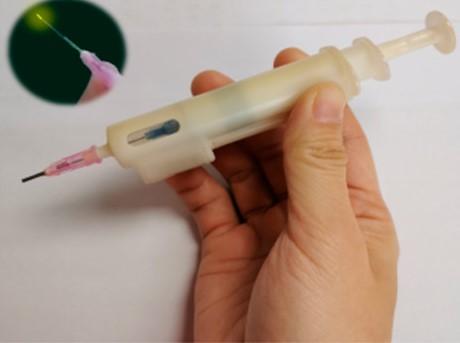
Credit: Adapted from ACS Materials Letters 2021, DOI: 10.1021/acsmaterialslett.0c00516
Exposure to some odorless, colorless and tasteless gases, such as nerve agents, can be toxic or even lethal. And having the ability to detect other types of vapors could save people from eating spoiled or rotten food. Easy-to-use portable devices could, therefore, go a long way toward protecting the public. Now researchers reporting in ACS Materials Letters have created a pen-like sensor that changes color when exposed to harmful gases.
Humans can’t detect many toxic vapors, such as poisonous nerve agents or volatile amines released from spoiled foods, so a sensor that can notice these gases’ very minute concentrations would be useful. Fluorescence-based sensors are a potential solution because they are inexpensive and can reveal trace amounts of compounds. However, some fluorescing compounds clump together once they react with gases, reducing their intensity, and they can require complex fabrication processes. Yet other fluorophores produce more intense light when they are clumped together — aggregation-induced emission fluorogens (AIEgens). Most of the current detection methods using AIEgens are liquid-based, requiring gases to be dissolved in solution before analysis, and are not easily portable. So, Zhe Jiao, Pengfei Zhang, Haitao Feng, Ben Zhong Tang and colleagues wanted to adapt AIEgens to be integrated into a needle-thin fiber, creating a handheld device whose tip “turns on” in the presence of a particular gas.
The researchers developed two AIEgen-based “handy pens,” one for identifying the nerve agent diethyl chlorophosphite (DCP) and the other for amines produced by rotting food. First, they coated silicon dioxide polymer fibers with a thin sol-gel layer to immobilize AIEgens. Next, they added an AIEgen that changes color when it reacts with DCP on one set of fibers, and an AIEgen that reacts with amines on another set. The coated fibers were then placed at the end of a pen-like device with a UV light source inside. The DCP sensor’s tip changed from a yellow fluorescence to blue within 30 minutes of exposure to DCP. The amine sensor’s tip was initially a mild blue-gray color, but it generated a vibrant yellow-colored light within five minutes when it was exposed to volatile amine vapors. Both sensors reverted to the original hue when exposed to neutralizing vapors, demonstrating that they were reversible. Finally, the team used the amine-responsive handy pen to distinguish between a salmon sample that had been refrigerated and one that had been left at room temperature for 48 hours. The researchers say that other handy pens could be easily developed by using different vapor-sensitive AIEgens, which could be applied to food safety, environmental monitoring or public safety applications.
###
The authors acknowledge funding from Science and Technology Planning Project of Guangdong Province of China, Educational Commission of Guangdong Province of China, the Social Science and Technology Development Project of Dongguan, Guangdong International Cooperation Project, the Science and Technology Plan of Shenzhen, the UNSW-CAS Collaborative Research Seed Fund Program and the Shenzhen Institute of Advanced Technology Innovation Program for Excellent Young Researchers.
The abstract that accompanies this paper is available here.
The American Chemical Society (ACS) is a nonprofit organization chartered by the U.S. Congress. ACS’ mission is to advance the broader chemistry enterprise and its practitioners for the benefit of Earth and its people. The Society is a global leader in providing access to chemistry-related information and research through its multiple research solutions, peer-reviewed journals, scientific conferences, eBooks and weekly news periodical Chemical & Engineering News. ACS journals are among the most cited, most trusted and most read within the scientific literature; however, ACS itself does not conduct chemical research. As a specialist in scientific information solutions (including SciFinder® and STN®), its CAS division powers global research, discovery and innovation. ACS’ main offices are in Washington, D.C., and Columbus, Ohio.
To automatically receive news releases from the American Chemical Society, contact [email protected].
Follow us: Twitter | Facebook
Media Contact
Katie Cottingham
[email protected]





